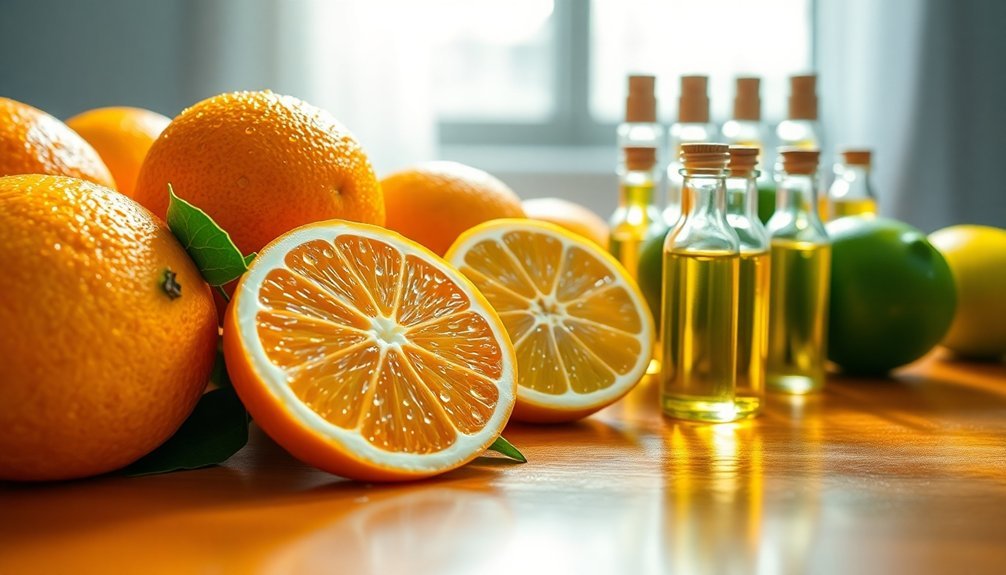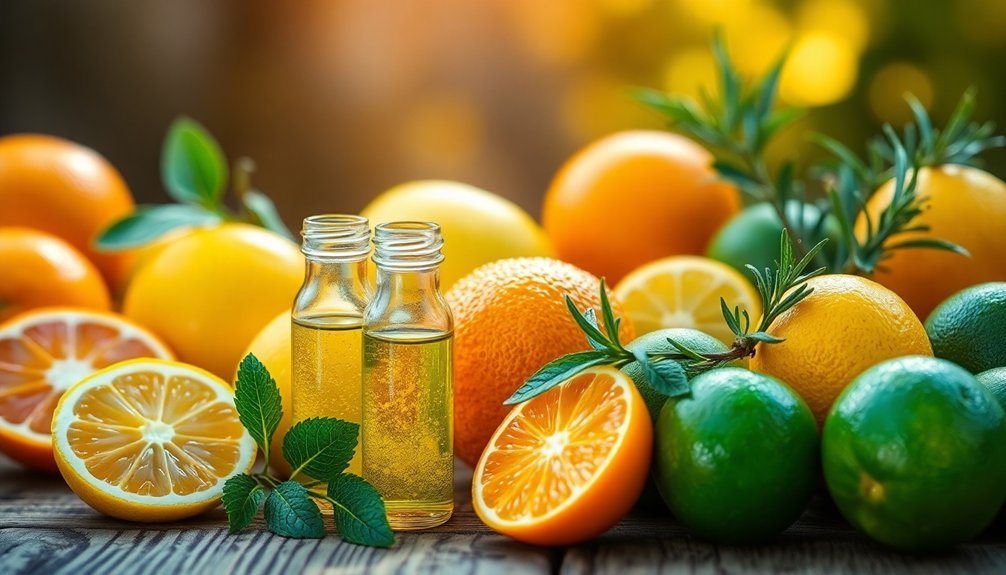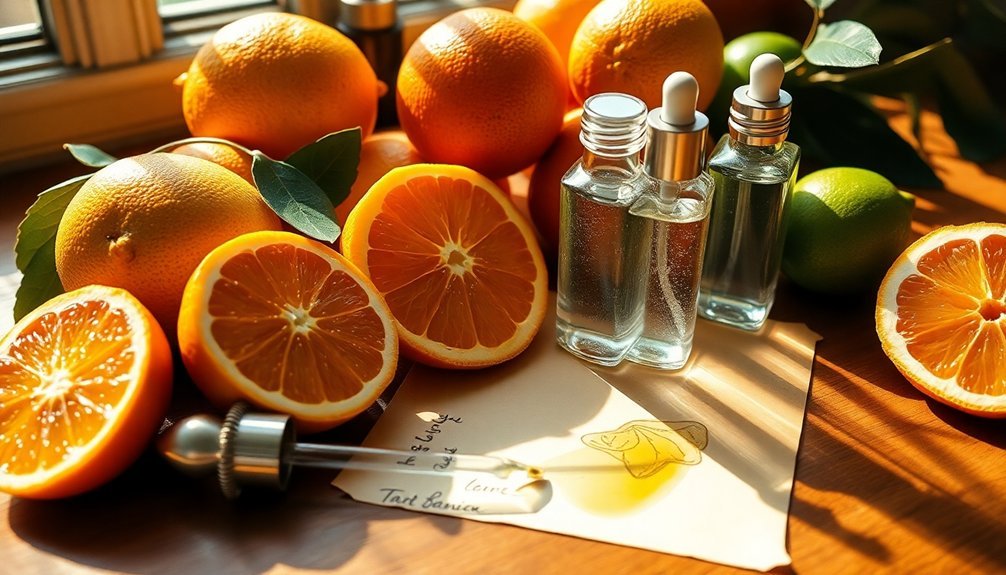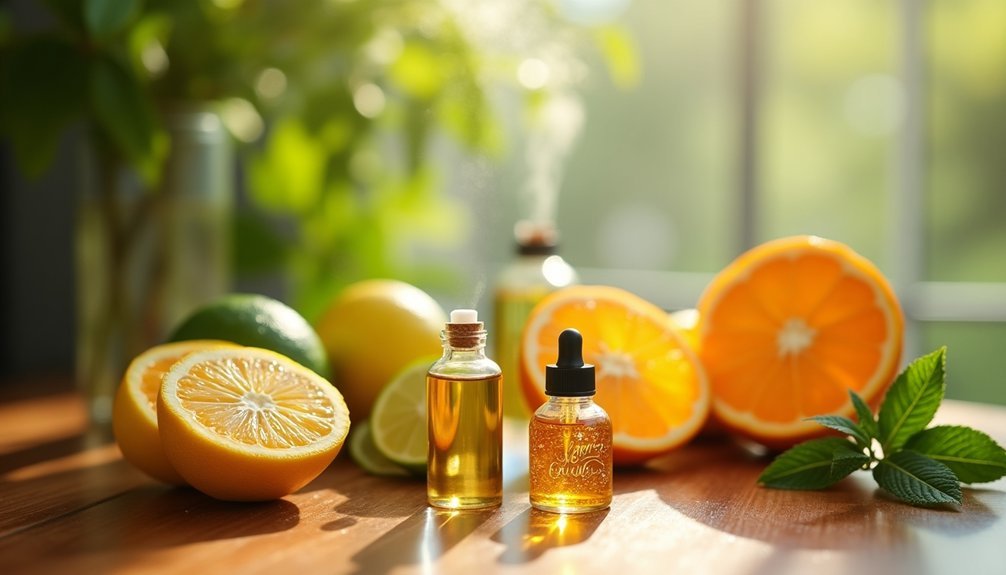Creating a fresh citrus perfume starts with vibrant top notes like lemon, bergamot, or orange peel that provide an initial burst of energy. You'll want to balance these with floral middle notes (15-20% concentration) such as jasmine or orange blossom, then anchor your blend with woody base notes like sandalwood or cedarwood. Follow the 30/50/20 ratio rule for a well-rounded composition, and don't forget fixatives like musk to enhance longevity. Master these fundamentals to reveal endless fragrance possibilities.
Understanding the Citrus Perfume Pyramid

When creating a citrus perfume, understanding the olfactory pyramid is essential to crafting a well-balanced fragrance.
You'll want to start with vibrant top notes, where citrus oils like orange, lemon, and bergamot shine brightest, creating that initial burst of freshness that lasts about 15 minutes. The science of fragrance composition ensures that notes overlap naturally, creating seamless transitions between layers.
Your middle notes will emerge as the citrus fades, bringing in complementary spices or fruity elements that give your perfume its distinctive personality.
These heart notes typically last several hours and form the core of your fragrance's character.
Finally, you'll need strong base notes to anchor your blend.
These heavy, persistent aromas, often woody or musky, provide the foundation that makes your citrus creation last.
They'll continue to evolve on the skin, ensuring your perfume maintains its depth throughout the day.
Essential Top Notes for Fresh Citrus Blends
As you begin crafting fresh citrus blends, top notes form the essential first impression of your perfume.
You'll find the most vibrant options come from fruit peels, with each citrus bringing its unique character. Lemon offers a tangy sweetness, while bergamot provides an enlivening zest that pairs beautifully with other citrus notes. Incorporating Lemon Myrtle essential oil adds a distinctive Australian twist to your blend.
For the best results, you'll want to reflect on blending these top notes strategically.
Try combining them with florals like jasmine for a feminine touch, or woods like cedarwood for a unisex appeal. They're particularly effective in morning fragrances and summer scents, where their cooling effect shines.
Remember that these notes are volatile and evaporate quickly, but they'll create that perfect, attention-grabbing opening that makes your blend immediately enchanting and invigorating.
Balancing Middle Notes in Your Formula

When creating citrus perfume blends, you'll need to carefully balance your floral middle notes, with jasmine and orange blossom working particularly well at a 15-20% concentration alongside citrus top notes.
Your spice notes, such as cardamom and cinnamon, should make up 5-10% of the middle note composition to guarantee a smooth shift without overwhelming the citrus character.
For a truly sophisticated profile, consider adding bamboo and white rose for an elegant dimension, as proven effective in classic formulations. These middle note ratios will help you achieve a harmonious blend that maintains its bright citrus identity while gaining depth and complexity through the heart of the fragrance.
Floral-Citrus Harmony Techniques
Creating harmonious floral-citrus blends requires a deep understanding of middle notes and their essential role in perfume composition. These heart notes form your fragrance's core character and help bridge the shift between opening and base notes.
When you're crafting your blend, pair vibrant citrus elements with complementary florals. Try combining grapefruit with neroli for an uplifting scent, or blend bergamot with lavender for a balanced harmony.
You'll want to reflect on the volatility of your ingredients – citrus notes evaporate quickly, so they need stable floral middle notes to maintain the fragrance's integrity.
Popular floral middle notes like jasmine, rose, and orange blossom can provide the depth you need while maintaining the fresh, bright character of your citrus elements.
Focus on achieving a smooth evolution between these components for a well-rounded perfume.
Spicy Transition Note Ratios
Balancing spicy middle notes demands precise ratios to achieve a harmonious citrus perfume blend. You'll want to start with a modest 15-20% spice concentration in your middle note composition to prevent overwhelming your citrus top notes.
When combining cinnamon, cardamom, or clove with your citrus blend, ascertain they complement rather than compete with your fruits and florals.
To create a seamless shift from top to base notes, you'll need to take into account the volatility of your spices. Pair black pepper or ginger with your citrus elements for a zesty lift, while keeping heavier spices like cinnamon at lower concentrations.
Remember to test your ratios carefully – you can always add more spice, but removing it isn't possible. The key is achieving a balanced core that enhances your citrus notes without masking their fresh character.
Base Notes That Anchor Citrus Fragrances
The art of anchoring citrus fragrances depends heavily on well-chosen base notes that transform fleeting top notes into long-lasting perfumes.
You'll find that woody elements like sandalwood and cedarwood provide a solid foundation, while vanilla and benzoin add essential warmth and sweetness to balance the bright citrus notes.
For a truly memorable citrus fragrance, consider these emotion-evoking base note combinations:
- Sandalwood + vanilla: Creates a cozy, comforting embrace that'll make you feel at home
- Musk + ambergris: Delivers a sensual, skin-like warmth that draws others closer
- Vetiver + patchouli: Offers an earthy, grounding energy that connects you to nature
- Rose + geranium: Introduces a romantic, garden-fresh charm that lifts your spirits
These anchoring elements don't just extend your fragrance's life – they transform it into a complex, layered masterpiece.
Key Fragrance Combinations for Lasting Scents

When you're working with citrus fragrances, you'll find that vetiver creates a magical grounding effect while adding an earthy sophistication to bright citrus notes.
Your citrus perfume's longevity improves considerably when you layer it with the right musk note, which acts as a fixative while adding sensual depth.
You can also extend your citrus scent's staying power by anchoring it with essential oils like patchouli or cedarwood, which provide a stable foundation for the volatile top notes.
Citrus-Vetiver Balance Magic
Creating magical citrus-vetiver combinations requires understanding three essential elements: bright top notes, earthy depth, and precise proportions.
You'll find the richest expressions of vetiver in oils from Haiti, India, and Indonesia, which perfectly complement the vibrant notes of bergamot, lemon, and orange essences.
- Experience the invigorating burst of fresh citrus awakening your senses
- Feel grounded by vetiver's mysterious earthy warmth
- Discover the perfect balance between light and dark notes
- Let the lasting presence of your signature scent captivate for hours
To craft your blend, start with citrus top notes, add floral or spicy middle notes, and anchor with vetiver base.
You can enhance complexity by incorporating black pepper, geranium, or coumarin. Test multiple versions until you find your perfect balance of brightness and depth.
Perfect Musk Layer Pairings
Mastering musk layering transforms ordinary citrus fragrances into sophisticated, long-lasting scents that'll captivate throughout the day. Start by applying musk body oil as your base layer, letting it dry for maximum absorption.
When combining citrus with musk, you'll notice how the musky undertones balance the bright, zesty notes while extending their freshness.
For a romantic twist, add floral elements like jasmine or neroli – they'll integrate beautifully with the musk as middle notes develop on your skin. If you're seeking a more grounded fragrance, incorporate woody notes like cedarwood or sandalwood.
You can boost your signature scent by adding complementary body powder or dry shampoo.
While musk typically lasts 4-6 hours, these strategic layering techniques will help your citrus fragrance maintain its allure longer.
Essential Oil Anchoring Techniques
The art of anchoring citrus fragrances requires strategic combinations of essential oils to transform fleeting top notes into enduring scents.
You'll find that pairing citrus oils with specific anchoring agents can dramatically enhance their longevity and depth. Litsea cubeba and lemongrass are your go-to fixatives for bright citrus notes, while patchouli and vetiver provide essential grounding elements.
- Blend lemon with lemongrass for an uplifting, authentic citrus experience that lasts
- Combine bergamot with sage and juniper for a sophisticated, herbaceous embrace
- Layer mandarin with mango and vetiver for an exotic, tropical escape
- Mix citrus notes with ylang ylang for a sensual, complex signature scent
When anchoring citrus oils, remember that base notes are vital for creating a well-rounded, lasting fragrance that captures attention.
Mastering the Art of Note Transitions

While perfume composition may seem like a simple blend of scents, successful note shifts require careful orchestration of top, heart, and base notes to create a harmonious fragrance journey. You'll want to focus on smooth changes between layers, ensuring each note complements the next while maintaining the citrus theme throughout.
| Layer | Timing | Key Elements |
|---|---|---|
| Top Notes | 15-30 mins | Bergamot, lemon, grapefruit |
| Heart Notes | 2-4 hours | Neroli, orange blossom, jasmine |
| Base Notes | 4+ hours | Sandalwood, vanilla, musk |
| Change | Throughout | Gradual layering, balanced ratios |
To achieve seamless changes, start with vibrant citrus top notes that gracefully fade into floral heart notes. Finally, anchor your blend with warm, woody base notes that'll provide lasting depth and sophistication to your citrus creation.
Perfecting Your Blend Ratios
Building on the concept of harmonious note changes, successful perfume creation hinges on precise blend ratios. For your citrus perfume, follow the 30/50/20 rule: 30% top notes, 50% middle notes, and 20% base notes. This creates a well-balanced fragrance that unfolds beautifully over time.
When working with citrus oils, you'll want to adjust these ratios slightly since citrus scents fade faster. Consider increasing your citrus proportion while maintaining harmony with other elements.
- Feel the burst of energy as vibrant top notes dance on your skin
- Experience the elegant heart of your perfume as it gracefully unfolds
- Discover the grounding comfort of earthy base notes
- Embrace the magical moment when all notes merge into your signature scent
Remember to test your blend with small quantities first, and let it mature for 48 hours before making final adjustments.
Customizing Your Signature Citrus Formula

Ready to create your own signature citrus perfume? Start by selecting your preferred citrus top notes – you might combine zesty lemon with sweet orange and sophisticated bergamot for a complex blend.
Then, add depth with middle notes like jasmine or lavender to balance the bright citrus tones.
Ground your creation with woody base notes such as cedarwood or sandalwood, which will help your fragrance last longer. For evening wear, consider adding spicy notes like cardamom or ginger.
Don't forget to test small batches first and adjust the ratios until you've achieved your perfect scent.
Once you're satisfied, dilute your blend with a carrier oil and let it mature for several days.
Store your creation in a dark glass container to preserve its vibrant qualities.
Frequently Asked Questions
How Long Does It Take to Master Perfume Blending From Scratch?
You'll need 5-10 years to master perfume blending. It takes dedication to develop your nose, understand ingredient interactions, practice blending techniques, and gain expertise through constant experimentation and refinement.
Can Natural Citrus Essential Oils Cause Skin Sensitivity or Allergic Reactions?
Yes, you'll need to be careful with citrus oils, especially cold-pressed ones. They can cause phototoxic reactions when exposed to sunlight and may trigger skin sensitivities in some people. Always dilute properly.
What Equipment and Storage Containers Are Essential for Home Perfume Making?
You'll need digital scales, glass beakers, pipettes, amber glass bottles, droppers, protective gear (gloves and glasses), labels, and fragrance blotters. Store your perfumes in dark glass containers to protect them.
How Do Temperature and Humidity Affect Citrus Perfume Preservation?
Your citrus perfumes will degrade faster in high heat and humidity. They're sensitive to temperature fluctuations, which cause oxidation. Store them at steady temperatures between 50-70°F and avoid humid spaces for best preservation.
Are There Sustainable Alternatives to Rare or Endangered Perfume Ingredients?
You'll find sustainable options like upcycled woods, lab-created musks, and ethically sourced botanicals that replace endangered ingredients. These alternatives maintain fragrance quality while protecting vulnerable species and supporting eco-friendly practices.
In Summary
You've now mastered the essentials of crafting fresh citrus perfumes. With your knowledge of the fragrance pyramid, note combinations, and proper ratios, you're ready to create your signature scent. Remember to balance bright top notes with anchoring base notes, and don't be afraid to experiment. Keep refining your formulas until you've achieved that perfect blend that captures your unique vision.
References
- https://shop.perfumersapprentice.com/c-50-bases-and-blends.aspx
- https://basenotes.com/community/threads/citrus-type-fragrance-feedback-needed-on-a-formula.506587/
- https://sinhp.github.io/files/posts/2018/little-brown-book.pdf
- https://basenotes.com/community/threads/formula-top-notes-citrus-middle-fresh-rose-base-vetiver.445003/
- https://img.perfumerflavorist.com/files/base/allured/all/document/2016/02/pf.0010.pdf
- https://www.sylvaine-delacourte.com/en-us/guide/the-olfactive-pyramid
- https://www.alyssaashley.com/blogs/blog/the-olfactory-pyramid
- https://sartorialmagazine.com/beauty/2024/2/5/the-science-of-perfume-decoding-the-composition-and-structure-of-fragrancesnbsp
- https://www.youtube.com/watch?v=6JEEVImZjCU
- https://candle-shack.com/blogs/all-blogs/the-fragrance-pyramid





Leave a Reply